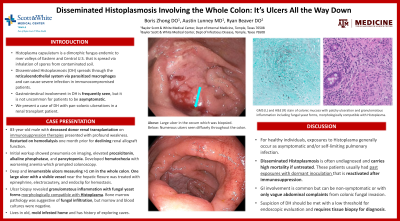Back


Poster Session B - Monday Morning
Category: Colon
B0152 - Disseminated Histoplasmosis Involving the Whole Colon: It's Ulcers All the Way Down
Monday, October 24, 2022
10:00 AM – 12:00 PM ET
Location: Crown Ballroom

Has Audio

Boris Zhong, DO, MS
Baylor Scott & White
Temple, TX
Presenting Author(s)
Boris Zhong, DO, MS1, Austin Lunney, MD2, Ryan Beaver, DO1, Daniel R. Brophy, BSc3
1Baylor Scott & White, Temple, TX; 2Baylor Scott and White, Temple, TX; 3Texas A&M College of Medicine, Temple, TX
Introduction: Histoplasma capsulatum is a dimorphic fungus endemic to river valleys of Eastern and Central U.S. that is spread via inhalation of spores from soil contaminated by bird or bat droppings. Disseminated Histoplasmosis (DH) spreads through the reticuloendothelial system via parasitized macrophages and can cause severe infection in immunocompromised patients with AIDS, hematologic malignancies, transplant recipients, and those receiving tumor necrosis factor (TNF)-alpha inhibitors or chronic corticosteroids. Gastrointestinal involvement in DH is frequently seen, but it is not uncommon for patients to be asymptomatic. We present a case of DH with pan-colonic ulcerations in a renal transplant patient.
Case Description/Methods: A 83-year-old male with deceased donor renal transplantation on immunosuppression therapies presented with profound weakness. He was restarted on hemodialysis one month prior for declining renal allograft function which had been stable for the past two decades. Initial workup showed pneumonia on imaging, elevated procalcitonin, alkaline phosphatase, and pancytopenia. He developed hematochezia with worsening anemia which prompted colonoscopy that revealed deep and innumerable ulcers measuring greater than one cm in the whole colon. One large ulcer with a visible vessel near the hepatic flexure was treated with epinephrine, electrocautery, and endoclip for hemostasis. Ulcer biopsy revealed granulomatous inflammation with fungal yeast forms morphologically compatible with Histoplasma by Grocott's Methenamine Silver (GMS) staining. Bone marrow pathology was suggestive of fungal infiltration, but marrow and blood cultures were negative. Family revealed he lives in an old mold infested home and has history of visiting caves. Treatment was initiated with liposomal Amphotericin B then transitioned to oral Itraconazole. He has continued to make a strong recovery and remains on dialysis.
Discussion: For healthy individuals, exposures to Histoplasma generally occur as asymptomatic to self-limited pulmonary infection. Disseminated Histoplasmosis is often undiagnosed and carries high mortality if untreated. These patients usually had past exposures with dormant inoculation that is reactivated after immunosuppression. GI involvement is common but can be non-symptomatic or with only vague abdominal complaints from colonic fungal invasion. Suspicion of DH should be met with a low threshold for endoscopic evaluation and requires tissue biopsy for diagnosis.

Disclosures:
Boris Zhong, DO, MS1, Austin Lunney, MD2, Ryan Beaver, DO1, Daniel R. Brophy, BSc3. B0152 - Disseminated Histoplasmosis Involving the Whole Colon: It's Ulcers All the Way Down, ACG 2022 Annual Scientific Meeting Abstracts. Charlotte, NC: American College of Gastroenterology.
1Baylor Scott & White, Temple, TX; 2Baylor Scott and White, Temple, TX; 3Texas A&M College of Medicine, Temple, TX
Introduction: Histoplasma capsulatum is a dimorphic fungus endemic to river valleys of Eastern and Central U.S. that is spread via inhalation of spores from soil contaminated by bird or bat droppings. Disseminated Histoplasmosis (DH) spreads through the reticuloendothelial system via parasitized macrophages and can cause severe infection in immunocompromised patients with AIDS, hematologic malignancies, transplant recipients, and those receiving tumor necrosis factor (TNF)-alpha inhibitors or chronic corticosteroids. Gastrointestinal involvement in DH is frequently seen, but it is not uncommon for patients to be asymptomatic. We present a case of DH with pan-colonic ulcerations in a renal transplant patient.
Case Description/Methods: A 83-year-old male with deceased donor renal transplantation on immunosuppression therapies presented with profound weakness. He was restarted on hemodialysis one month prior for declining renal allograft function which had been stable for the past two decades. Initial workup showed pneumonia on imaging, elevated procalcitonin, alkaline phosphatase, and pancytopenia. He developed hematochezia with worsening anemia which prompted colonoscopy that revealed deep and innumerable ulcers measuring greater than one cm in the whole colon. One large ulcer with a visible vessel near the hepatic flexure was treated with epinephrine, electrocautery, and endoclip for hemostasis. Ulcer biopsy revealed granulomatous inflammation with fungal yeast forms morphologically compatible with Histoplasma by Grocott's Methenamine Silver (GMS) staining. Bone marrow pathology was suggestive of fungal infiltration, but marrow and blood cultures were negative. Family revealed he lives in an old mold infested home and has history of visiting caves. Treatment was initiated with liposomal Amphotericin B then transitioned to oral Itraconazole. He has continued to make a strong recovery and remains on dialysis.
Discussion: For healthy individuals, exposures to Histoplasma generally occur as asymptomatic to self-limited pulmonary infection. Disseminated Histoplasmosis is often undiagnosed and carries high mortality if untreated. These patients usually had past exposures with dormant inoculation that is reactivated after immunosuppression. GI involvement is common but can be non-symptomatic or with only vague abdominal complaints from colonic fungal invasion. Suspicion of DH should be met with a low threshold for endoscopic evaluation and requires tissue biopsy for diagnosis.

Figure: (A) Large ulcer in the cecum which was biopsied. (B) Numerous ulcers seen diffusely throughout the colon. (C, D) H&E and Grocott’s Methenamine Silver (GMS) stain of colonic mucosa with patchy ulceration and granulomatous inflammation including fungal yeast forms, morphologically compatible with Histoplasma.
Disclosures:
Boris Zhong indicated no relevant financial relationships.
Austin Lunney indicated no relevant financial relationships.
Ryan Beaver indicated no relevant financial relationships.
Daniel Brophy indicated no relevant financial relationships.
Boris Zhong, DO, MS1, Austin Lunney, MD2, Ryan Beaver, DO1, Daniel R. Brophy, BSc3. B0152 - Disseminated Histoplasmosis Involving the Whole Colon: It's Ulcers All the Way Down, ACG 2022 Annual Scientific Meeting Abstracts. Charlotte, NC: American College of Gastroenterology.
